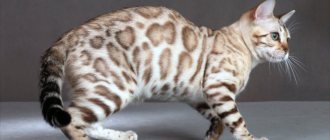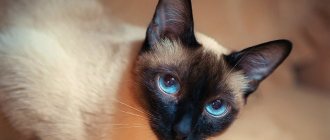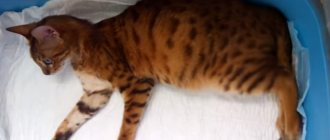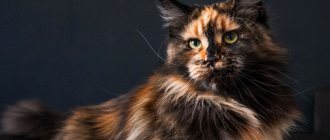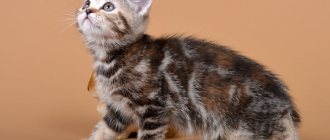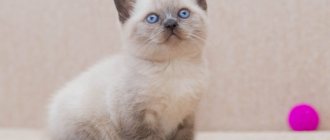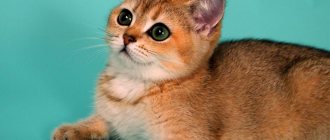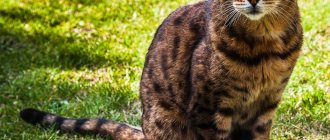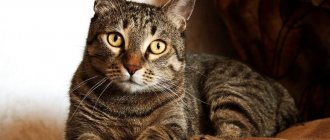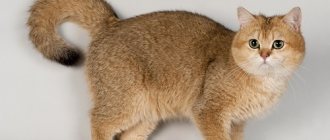Features of tabby color
This color is also called patterned or patterned. It is characterized by distinctive features:
- the letter "M" on the animal's forehead;
- two layers of fur: the first determines the background, the second sets the pattern;
- the ring pattern on the chest resembles rings
- necklace;
- continuous stripes on the paws and tail;
- eyeliner and nose to match the color of the cat;
- up to two rows of spots on the belly;
- There is a light spot on the outside of the ears.
Character and behavior
We are talking about a peace-loving and balanced pet who is likely to find a common language with both children and other pets. The Asian cat is inquisitive and intelligent, and does not show aggression or importunity. The pet takes part with great pleasure in games that require activity and attention from the owner. The Asian tabby is the personification of restraint and good manners. The cat will never bother its owner, but will wait until he has a moment for his pet.
As for Asian tabby kittens (the photo eloquently demonstrates the incredible beauty of these animals), we can only say one thing - even Abyssinians can envy their energy. It seems that they have a jet engine under their tail, which constantly pushes them in search of new adventures. And, I must say, very often they find them. Therefore, if you become the owner of a tiny “Asian”, try to protect the space around him as much as possible. Curtains, expensive vases and interior items, wires and large boxes, indoor flowers and aquariums - kids will try their best to climb into places where sometimes no human has gone before.
Asian cats quickly become attached to their owners. More often they choose one person from the family, recognizing him as the “leader” of the pack. The cat tolerates separation from its owner quite calmly, but this quality should not be abused - with frequent absence, the cat may become depressed or simply “change” the person to another owner who pays more attention to her. The Asian tabby has a special attitude towards small children - in almost all cases, the pet surrounds the “human cub” with its care and love, playing with it and allowing it to do with itself things that it would not allow an adult to do. But you shouldn’t delude yourself - the wayward “Asian” knows her worth, so she is always wary of strangers, will let you know if she doesn’t like something in their behavior, and will always stay away from places where other pets like to play.
- Health
- Intelligence
- Activity
- Talkativeness
- Difficulties in care
- Friendliness
- Weasel
- Shedding
Recognizable appearance
The British cannot be confused with anyone else: a muzzle with a weakly defined “stop” and slightly rounded ears, huge eyes of a predominantly golden color and large cheeks that just want to be squeezed. And because of their plush fur, you don’t want to let go of them at all. Short-legged, with a massive body weighing on average 5-7 kg. The coat comes in both long and short hair.
British Shorthair
They have a short and thick six with a healthy shine. It feels elastic and soft to the touch.
British Longhairs
Six british longhair of medium length with thick undercoat. Feels more “plush” than British Shorthair cats.
striped british photo:
Hygiene
Asian women do not like water at all, so they need to bathe no more than twice a year. Or just monitor the condition of the coat; as soon as it becomes dirty, give it a bath. In this case, you should use only high-quality cosmetics that will not cause allergies. Moreover, the skin is extremely sensitive. Clean your ears more often.
Silver tabby
Types of colors
British tabby cats have light, muted tones as their main color. The drawing has a dark color that contrasts with the main one.
Lilac
The main color of the Briton is beige with a hint of purple markings. A special feature is the pink nose and pads on the paws, which look very gentle.
Silver
The British silver tabby cat has a delicate bluish tint. The pads on your pet's paws may have the same shade or pinkish.
Gold
The main shade is gold, and the pattern on the body is made in various coat colors several shades darker. Golden tabby is divided into several more types of color: black, blue, chocolate (brown) and color-point.
Blue
The main color of cats is a light blue tint, including not only the fur, but also the nose and paw pads. The color is interesting because it is dominant: when the offspring appear, most of the kittens will have exactly this color. A dark blue pattern is observed throughout the body.
Red
On the body, the main shade of which is cream or silver, there is a pattern of bright orange color (compared to a red sunset).
Diseases and life expectancy
Asian cats have excellent health. No predisposition to hereditary mutations has been recorded in this cat breed. The most common causes of deterioration in a pet’s well-being are:
- lack of minerals and vitamins;
- unbalanced diet;
- lack of human communication.
Do not forget about systematic veterinary examinations, deworming and vaccination. If the breed will not be bred, it is recommended that the female cat be spayed or neutered. At the same time, experts note that spayed and neutered pets have an increased tendency to obesity.
With proper care, tabbies can live 15 to 20 years.
Types of drawings
Tabby is not one specific pattern, as many people believe. There are several varieties of it, and all are considered standard. The pattern appears due to the A gene (agutti). A British female with the color formula “AA” gives birth to only patterned kittens, and with “Aa” the ratio of patterned kittens to plain ones is 50%. Cats with the formula “aa” will be monochromatic.
There are four main types of tabby patterns: ticked, striped, marbled, spotted.
Ticked (Abyssinian)
At first glance, it may seem that the British ticked coat is a solid color, but this is not the case. The color of their coat is not at all uniform: the whole body has barely noticeable stripes, spots or specks (there are “freckles”), slightly darker than the main tone of the British. The tip of the tail is usually dark. Eyes are golden or green.
Striped, brindle (mackerel)
The British tabby cat is the most popular cat available. The second name appeared due to the similarity with the color of the mackerel fish. The pattern is characterized by frequent narrow, clear stripes throughout the body, especially along the ridge. British tabbys are characterized by necklace-like lines on the chest and a broken stripe on the forehead, reminiscent of the Russian letter “M”. The British cat's full brindle coloration develops by the age of one year.
Classic (marble)
One of the most favorite colors among breeders of this breed is the marbled tabby. It is visible already from the birth of the kitten, it may merge slightly, but by two months it has a clear pattern. The body is covered with wide ornate patterns with clear outlines on the back, sides and vague ones on the abdomen and paws. The color of the pattern contrasts with the main shade of the Briton’s body – a kind of marble on silver.
Spotted (leopard)
A cat of the British breed with this coloring is similar to a representative of the wild - a leopard, but in miniature. Wide stripes are intermittent and represent spots of various sizes. Eye color: copper, green.
Marble (classic, blotched/marble tabby)
It is the most recessive form of the tabby (tb) gene and the most striking of all patterned colors. On the shoulder blades there is a characteristic pattern in the form of butterfly wings, three wide stripes stretch along the back, concentric circles with a center on the sides, the tail has 2-3 wide stripes, and not many thin ones like a tiger. Ideally, the pattern should be thick and clear, contrasting with the main background. It has a modification - marble, which differs from the classic one in that it has thicker edges and a pale middle (bordered).
Who is suitable for a British tabby?
If you consider the main qualities of a pet to be affection and the ability to cuddle it, then this breed is not for you.
British cats have an independent character and live “on their own.” They are not attached to any family member. They are not afraid of loneliness, and therefore are suitable for business people who stay at work for a long time.
The British do not require additional education. They are clean, and therefore the cat's litter box will have to be changed more often than usual: these clean people can ignore the dirty toilet and relieve themselves in another place. But in general they rarely bully.
Their coat does not require special care. Animals take care of their hygiene independently.
The British tabby dog will be a great friend for a child. However, he will not accept excessive affection from him: British cats do not like excessive attention to their person, and will not sit on your hands. Rarely shows aggression, and therefore can get along even with dogs. British kittens are very playful up to a year old, but with age they become lovers of lounging on the sofa.
Their motto in life becomes the phrase: “Once you’ve eaten, you can sleep.” If you sleep, you can eat.” With such a lifestyle, it is important for the breeder to ensure that the pet does not gain excess weight.
Walking your pet and favorite place
The Asian tabby is a true homebody. This makes it different from other breeds. They don't need walks on the street at all. On the contrary, it will be much more pleasant for them to spend time with their owner at home, or in a secluded place alone. Therefore, you should not “drag” it into the street.
Since cats of this breed are reclusive creatures that prefer solitude, it is necessary to buy or make a personal home for them yourself. In winter, you can insulate it or simply supplement it with soft pillows.
The cat will be glad if, from the moment of her appearance, the house has not just a separate corner for her, but a whole play complex. In this case, the animal will know where to sharpen its claws, play or just relax. Such house-complexes will protect your furniture from scratching. If it is not possible to equip a personal corner, buy toys for your pet.
Disqualifying Faults
In addition to the reasons common to representatives of all breeds (non-conformity, color falsification, unkempt appearance, signs of disease, the presence of parasites, aggressiveness, oligo- and polydactyly, cryptorchidism in cats, tail defects)
The grounds for disqualifying a Siberian cat are:
- pronounced signs of the Persian type;
- deafness of cats and white cats (according to the rules of European rings);
- umbilical and inguinal hernias (Neva masquerade hernias are susceptible to their occurrence).
This is interesting! However, situations where Siberian cats are deprived of an exhibition rating are quite rare: high standard qualities and good health are signs reinforced by the professional, serious work of Russian felinologists.
Return to content
Key facts
The Asian tabby is the most prominent representative of the Asian group of cats. These wise, sedate, regal-looking animals are not picky in their choice of food and daily care.
Cats are the perfect combination of sociability and kindness, as well as strength and courage. Animals are not aggressive or vindictive, but will always be able to stand up for their offspring and themselves. They are friends with small children and other pets. Thanks to their calm nature, animals can easily tolerate prolonged loneliness.
Description of the breed The Asian tabby combines an original appearance and an accommodating, peaceful character. These pets feel equally at home in large houses and small city apartments. They are quite mobile, prone to active games and climbing - which is why they need a large number of jumping equipment and soft toys.
Characteristics of the Asian tabby cat breed include interesting facts:
- Country of origin: Great Britain, 1982. The short-haired Burmese cat was crossed with a Persian chinchilla. The resulting hybrid was bred with an Abyssinian, then again with a Persian, and as a result they got a medium-sized cat with short and thick hair.
- The Asian tabby's personality traits are friendly and they get along easily with cats and dogs. They do not occupy a dominant position, but they can always protect themselves and their offspring.
- With proper care and nutrition, the life expectancy of an Asian tabby is 15-18 years.
- Daily grooming is not necessary - due to the short hair of pets, it is enough to brush them once every 7-10 days with a soft brush. Teeth should be brushed several times a week.
Elite breed cats sense their owner’s mood and are always ready to provide emotional support. They quickly adapt to new living conditions, love affection and attention, but never show intrusiveness. Over the years, the cat becomes the favorite of the family; at the same time, it treats strangers with indifference.
Brief history of the breed
This breed originated in the 80s of the last century. It originates from Siberian cats that lived in Russia for centuries. For the first time, breeders of the Kotofey club in Leningrad began breeding Neva Masquerade cats. The work on creating a new breed was led by Olga Mironova, a well-known felinologist at that time.
There is no exact information about the origin of the point color. It is believed that the dark mask of Siberian masquerade cats appeared due to crossing with representatives of the Siamese breed. Some believe that this color was borrowed from color-point Persians.
In 1988, the Neva Masquerade cat took part in an exhibition for the first time, which was held in Leningrad. It was there that the breed got its name, which reflects the place of its origin - this is a city on the Neva. The word “masquerade” perfectly describes the main feature of its appearance - a dark mask on its face. In addition to the official name, the breed has others - carnival cat, nevak.
A little later, Moscow breeders began breeding Siberian Masquerade. However, they preferred to work separately from their Leningrad colleagues. Thanks to this, over time, a wide variety of new colors appeared.
In the early 90s, Russian felinologists began to promote the breed on the international stage. This gave good results - in 1992, the WCF organization registered the Siberian masquerade cat.
Most felinological associations still do not recognize the Neva Masquerade as a separate breed. It is listed in the registers as a color variety of Siberian cats.
